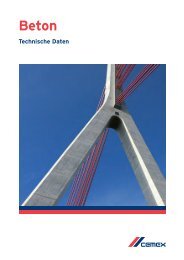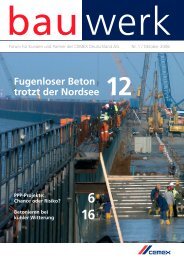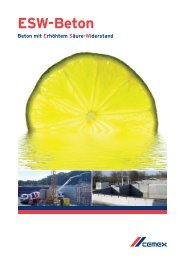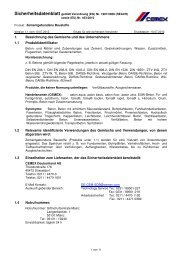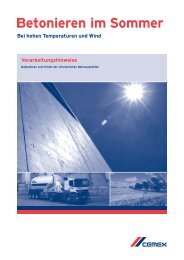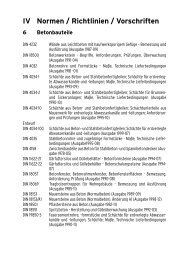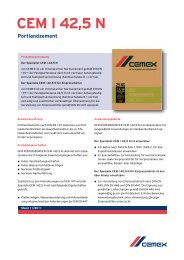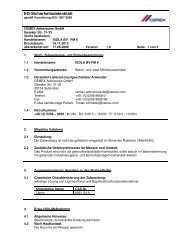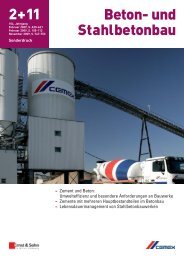building a better future - Cemex
building a better future - Cemex
building a better future - Cemex
Create successful ePaper yourself
Turn your PDF publications into a flip-book with our unique Google optimized e-Paper software.
ALTERNATIVE FUEL SUBSTITUTION RATE<br />
percentage<br />
0.8<br />
5.1<br />
16.4<br />
20.3<br />
90 05 09 10 11<br />
Alternative fuel substitution rates for cement<br />
operations - CEMEX has significantly increased<br />
its usage of alternative fuels as a percentage<br />
of total fuel usage, companywide by investing<br />
more than US$ 175 million since 2005.<br />
Chelm Cement Plant in Poland.<br />
76% of the energy required comes<br />
from alternative fuels<br />
24.7<br />
leading our industry in the use of alternative fuels<br />
In an effort to reduce GHG emissions and improve our fuel<br />
and energy security, we have explored a wide variety of coal<br />
and fossil-fuel alternatives to power our cement operations.<br />
Alternative fuels are predominantly residues or byproducts<br />
from industrial, domestic, agricultural, and forestry processes—<br />
including used tires; spent solvents and waste oils; processed<br />
municipal solid waste; and biomass such as rice and coffee<br />
husks, animal meal, and sewage sludge—all of which contain<br />
recoverable energy.<br />
CEMEX is one of the leading users of alternative fuels in<br />
the cement industry. CEMEX is pursuing a goal to reach an<br />
alternative fuel substitution rate of 35 percent by 2015—the<br />
most ambitious rate among its global competitors. Exemplifying<br />
current trends, we scaled up the use of alternative fuels at<br />
our Brocēni plant in Latvia from 32.1 percent in 2010 to 58.2<br />
percent in 2011 during the plant’s first year of full-scale production.<br />
Building upon technologies and operational expertise<br />
from other CEMEX plants—particularly those in Germany—the<br />
Brocēni plant utilizes an advanced kiln design that reduces energy<br />
consumption by 50 percent compared with its traditional<br />
counterparts and allows for broader fuel compatibility.<br />
CEMEX’s longstanding commitment to fossil-fuel reduction is<br />
evident throughout our worldwide operations. In 2011, nine<br />
cement plants surpassed a 50 percent alternative fuel rate,<br />
with three of them reaching a rate above 75 percent.<br />
90%<br />
of our cement plants<br />
burned alternative fuels<br />
during 2011, thus avoiding<br />
the use of around 2 million<br />
tons of coal<br />
CEMEX in the Philippines is<br />
partnering with two environmental<br />
groups to implement a USD10<br />
million, alternative-fuels project at<br />
its Solid Cement plant near Manila.<br />
The joint project will convert<br />
biodegradable, non-recyclable<br />
waste into alternative fuels<br />
clinker reduction<br />
In 2011, our overall clinker factor (the ratio of clinker content<br />
to total cement production) was 75.1 percent—down from 84.3<br />
percent in 1990. We have achieved this overall reduction by increasing<br />
the use of alternative cementitious materials, many of<br />
which are derived from the waste streams of other industries.<br />
These materials include, among others:<br />
• Fly ash – a combustion residue from coal-fired power plants<br />
• Blast furnace slag – a by-product of pig iron production<br />
• Pozzolan – a fine, sandy volcanic ash<br />
Though we strive to maximize our usage of alternative raw<br />
materials, the reduction of our clinker factor depends largely<br />
on market demand for our products—some of which require<br />
higher clinker content than others. Additionally, the availability<br />
of high-quality clinker alternatives poses a significant<br />
bottleneck to our rate of substitution. Nonetheless, we are<br />
committed to finding new ways of sourcing and using clinker<br />
alternatives without compromising the performance of our<br />
<strong>building</strong> materials.<br />
< previous 21 next>



